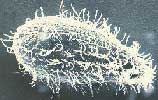Parasites In Humans
Find The Nastiest Parasites In Humans
Balantidium ColiBalantidium coli is the largest protozoan parasite in humans and causes a disease called balantidiasis. It belongs to the ciliophora phylum and is the only protozoan ciliate to infect humans. It goes through two development phases; a cyst and a trophozoite. Trophozoites are 0.03–0.15 mm long and 0.025–0.12 mm wide. Their shape is either spherical or oblong. Their surface is covered with cilia and are able to move around. Trophozoites have both a micronucleus and a macronucleus, which both are normally visible. The macronucleus is bigger and sausage-shaped whereas the micronucleus is less notable. Cysts are spherical and 0.04–0.06 mm in diameter. They have a tough multilayered shell which protects them against stomach acid of the host, when ingested. They are usually destroyed at a pH lower than five (normal pH of a healthy stomach is about three). Some people are weakened by other diseases and thus the cysts are not killed. Unlike trophozoites, cysts cannot reproduce and do not have any cilia for moving. The life cycle of Balantidium coli begins, when a human eats food or water that has been contaminated with infective cysts. If the cysts survive through the stomach, trophozoites are formed in the small intestine. Trophozoites live in the cecum and the colon of the large intestine. They live and feed in the lumen but sometimes penetrate the mucosa. They multiply by transverse binary fission in the intestinal wall. Some trophozoites return to the lumen and encyst (transform into cysts) once the feces dry up. The cysts are formed either in the large intestine or outside of the body. If the feces get in contact with vegetables or drinking water, humans might ingest the cysts.
About 1 % of the world's population is infected with balantidiasis. Most infections occur in developing countries where feces are more likely to get in contact with food and drinking water. In addition to humans, pigs and other animals carry the disease. People who raise pigs have bigger risk of getting infected with balantidiasis. Balantidiasis is often asymptomatic. But in some cases the patient might have diarrhea, weight loss and dysentery. Dysentery is an inflammatory disorder of the intestine, particularly of the colon, that causes severe diarrhea containing blood and/or mucus in the feces with stomach pain and fever. Untreated dysentery cases can be fatal.
Balantidiasis is treated with tetracycline according to the instructions of your health care provider. Tetracycline is not recommended for pregnant women or children under 8 years old. If the drug is not available, then iodoquinol and metronidazole can be used. Balantidiasis infections can be prevented by following proper hygiene practices. Do not use human feces as fertilizer in agriculture. Wash your hands after going to the toilet and before meal. Only drink pure water. Wash vegetables and cook meat properly. Infective Balantidium coli cysts are killed by heat. Also check out the videos.
|
Parasites In Humans Pictures And Videos Contact Info Privacy Policy Sitemap
© 2010–2015 parasitesinhumans.org

 Diagnosis can be made by finding trophozoites from a
stool or tissue sample (collected during endoscopy). Cysts are rarely found. Trophozoites are passed
irregularly and quickly destroyed outside the colon. For this reason many stool samples are usually required
to confirm the disease.
Diagnosis can be made by finding trophozoites from a
stool or tissue sample (collected during endoscopy). Cysts are rarely found. Trophozoites are passed
irregularly and quickly destroyed outside the colon. For this reason many stool samples are usually required
to confirm the disease.